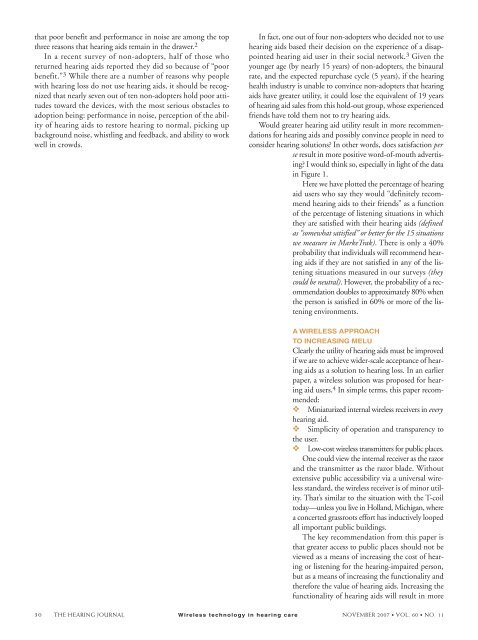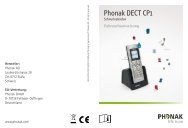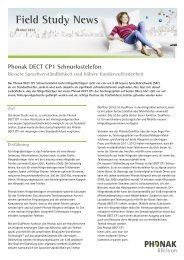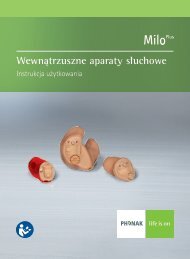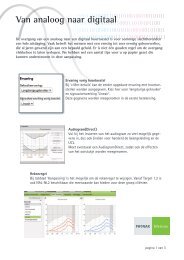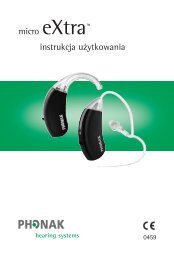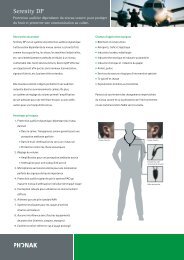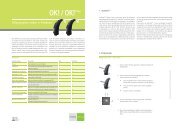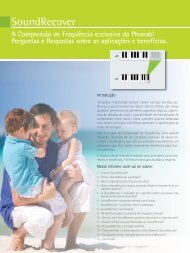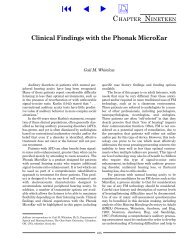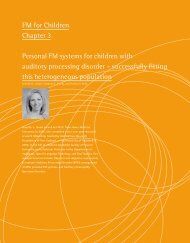Increasing hearing aid adoption through multiple ... - Phonak
Increasing hearing aid adoption through multiple ... - Phonak
Increasing hearing aid adoption through multiple ... - Phonak
Create successful ePaper yourself
Turn your PDF publications into a flip-book with our unique Google optimized e-Paper software.
that poor benefit and performance in noise are among the top<br />
three reasons that <strong>hearing</strong> <strong>aid</strong>s remain in the drawer. 2<br />
In a recent survey of non-adopters, half of those who<br />
returned <strong>hearing</strong> <strong>aid</strong>s reported they did so because of “poor<br />
benefit.” 3 While there are a number of reasons why people<br />
with <strong>hearing</strong> loss do not use <strong>hearing</strong> <strong>aid</strong>s, it should be recognized<br />
that nearly seven out of ten non-adopters hold poor attitudes<br />
toward the devices, with the most serious obstacles to<br />
<strong>adoption</strong> being: performance in noise, perception of the ability<br />
of <strong>hearing</strong> <strong>aid</strong>s to restore <strong>hearing</strong> to normal, picking up<br />
background noise, whistling and feedback, and ability to work<br />
well in crowds.<br />
In fact, one out of four non-adopters who decided not to use<br />
<strong>hearing</strong> <strong>aid</strong>s based their decision on the experience of a disappointed<br />
<strong>hearing</strong> <strong>aid</strong> user in their social network. 3 Given the<br />
younger age (by nearly 15 years) of non-adopters, the binaural<br />
rate, and the expected repurchase cycle (5 years), if the <strong>hearing</strong><br />
health industry is unable to convince non-adopters that <strong>hearing</strong><br />
<strong>aid</strong>s have greater utility, it could lose the equivalent of 19 years<br />
of <strong>hearing</strong> <strong>aid</strong> sales from this hold-out group, whose experienced<br />
friends have told them not to try <strong>hearing</strong> <strong>aid</strong>s.<br />
Would greater <strong>hearing</strong> <strong>aid</strong> utility result in more recommendations<br />
for <strong>hearing</strong> <strong>aid</strong>s and possibly convince people in need to<br />
consider <strong>hearing</strong> solutions? In other words, does satisfaction per<br />
se result in more positive word-of-mouth advertising?<br />
I would think so, especially in light of the data<br />
in Figure 1.<br />
Here we have plotted the percentage of <strong>hearing</strong><br />
<strong>aid</strong> users who say they would “definitely recommend<br />
<strong>hearing</strong> <strong>aid</strong>s to their friends” as a function<br />
of the percentage of listening situations in which<br />
they are satisfied with their <strong>hearing</strong> <strong>aid</strong>s (defined<br />
as “somewhat satisfied” or better for the 15 situations<br />
we measure in MarkeTrak). There is only a 40%<br />
probability that individuals will recommend <strong>hearing</strong><br />
<strong>aid</strong>s if they are not satisfied in any of the listening<br />
situations measured in our surveys (they<br />
could be neutral). However, the probability of a recommendation<br />
doubles to approximately 80% when<br />
the person is satisfied in 60% or more of the listening<br />
environments.<br />
A WIRELESS APPROACH<br />
TO INCREASING MELU<br />
Clearly the utility of <strong>hearing</strong> <strong>aid</strong>s must be improved<br />
if we are to achieve wider-scale acceptance of <strong>hearing</strong><br />
<strong>aid</strong>s as a solution to <strong>hearing</strong> loss. In an earlier<br />
paper, a wireless solution was proposed for <strong>hearing</strong><br />
<strong>aid</strong> users. 4 In simple terms, this paper recommended:<br />
❖ Miniaturized internal wireless receivers in every<br />
<strong>hearing</strong> <strong>aid</strong>.<br />
❖ Simplicity of operation and transparency to<br />
the user.<br />
❖ Low-cost wireless transmitters for public places.<br />
One could view the internal receiver as the razor<br />
and the transmitter as the razor blade. Without<br />
extensive public accessibility via a universal wireless<br />
standard, the wireless receiver is of minor utility.<br />
That’s similar to the situation with the T-coil<br />
today—unless you live in Holland, Michigan, where<br />
a concerted grassroots effort has inductively looped<br />
all important public buildings.<br />
The key recommendation from this paper is<br />
that greater access to public places should not be<br />
viewed as a means of increasing the cost of <strong>hearing</strong><br />
or listening for the <strong>hearing</strong>-impaired person,<br />
but as a means of increasing the functionality and<br />
therefore the value of <strong>hearing</strong> <strong>aid</strong>s. <strong>Increasing</strong> the<br />
functionality of <strong>hearing</strong> <strong>aid</strong>s will result in more<br />
30 THE HEARING JOURNAL Wireless technology in <strong>hearing</strong> care NOVEMBER 2007 • VOL. 60 • NO. 11


